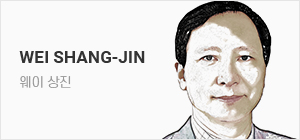이 기사는 해외 석학 기고글 플랫폼 '헤럴드 인사이트 컬렉션'에 게재된 기사입니다.
 |
| 국정 지지율이 급락해 정치적으로 운신의 폭이 좁아진 기시다 후미오 일본 총리가 지난해 11월 초 필리핀을 방문했을 때 모습 [게티이미지] |

In Japan, the Kishida Cabinet‘s approval ratings have fallen to critical levels over the last few months. The cabinet was inaugurated when Fumio Kishida took charge as Japan’s prime minister in October 2021, after Yoshihide Suga, the former prime minister, stepped down because of a decline in his approval ratings. The Kishida Cabinet‘s approval ratings were high during the first ten months. During that period, Prime Minister Kishida presented the concept of “new capitalism” as the cornerstone of his economic policy and emphasized the importance of strengthening Japan’s economy from the supply side. This was a clear departure from “Abenomics” (the economic policy of the Abe administration), which relied heavily on monetary easing by the Bank of Japan to stimulate the economy from the demand side. This demonstrated a firm commitment to structurally reform the Japanese economy and extricate it from long-term stagnation. However, the Kishida Cabinet‘s approval rating began to decline after August 2022. This decline accelerated after the Hiroshima G7 Summit, which was held in May 2023.
One of the direct triggers for this decline has been an increase in consumer prices. In Japan, prices had been stagnant for a long time, increasing only moderately initially, even amid soaring global prices. However, the rate of increase in consumer prices, which was gradual in early 2022, accelerated dramatically in the summer of 2022, exceeding that of the previous year by 3%. In particular, the increase in prices of food, energy, and other daily necessities was serious. Many Japanese people got frustrated with the administration‘s sluggish response to stabilize price increases.
The resultant sharp drop in approval ratings forced the Kishida administration to amend its economic policies dramatically. Policies to strengthen the Japanese economy from the supply side were shelved because they were considered to have no immediate effect. Instead, a series of ad hoc demand-side policies were adopted to quell the growing dissatisfaction of people. However, these were stopgap measures in the sense that their objectives and effects were not explored well. They were far from sufficient to relieve people‘s dissatisfaction with rising prices.
A notorious example is the commitment to a flat tax cut that Prime Minister Kishida suddenly announced in October 2023. The prime minister explained that a tax cut was desirable because tax revenues increased as a result of rising prices. The implementation of the tax cut, which is expected to be in the mid 3 trillion range, became the default policy in subsequent policy discussions. However, it was nothing more than a ‘claptrap’ policy aimed at restoring Kishida‘s approval ratings. A huge amount of money for the tax cut will be funded by new government debt. This is not feasible in Japan’s current fiscal situation. In response to growing criticism, the prime minister justified the tax cut first by the need to overcome the deflationary economy and then by the need to support child-rearing. The justification went back and forth, because the verification of the policy‘s objectives and effects was immature.
Japan‘s outstanding government debt has already been unprecedented, exceeding 2.5 times its GDP (gross domestic product). No advanced country in the world has such a significant government debt. In particular, Japan’s declining birth rate and aging population are expected to continue at an unprecedented pace. Social security spending, which has been increasing steadily, is expected to increase dramatically in the near future. Regardless of how optimistic the estimates are, this will undoubtedly become a major obstacle to fiscal consolidation. Almost all Japanese people are aware of this inconvenient truth and have serious concerns about the easy fiscal stance of only increasing government debt.
The Kishida administration had decided to drastically increase defense spending and childcare subsidies before announcing the tax cuts. To finance the large increase in defense spending, the administration initially assumed it would increase income, corporate, and other taxes. However, when many criticized its contradiction with the impending tax cut, it suddenly stopped arguing the tax increases without showing alternative financial resources. To finance unprecedented childcare subsidies, the administration explained that it would create a child-rearing support fund by utilizing social insurance premiums. However, it also explained that the fund would not burden people because other social insurance premiums would be substantially reduced through social security spending cuts and wage increases. The explanations are not based on solid evidence and are, therefore, unreasonable.
Many Japanese people now recognize the need to drastically strengthen their defense capabilities because the national security environment surrounding Japan is rapidly becoming severe. They also recognize the need to expand childcare subsidies because the birth rate is declining and society is aging. Neither of these fiscal expenditures is feasible without increasing the taxpayers‘ burden. Many Japanese people are now skeptical of Kishida’s deceptive explanation that increased fiscal expenditure would not increase people‘s burdens.
It is now inevitable to have serious public debates on how significant “burdens” and “mutual support” are necessary to realize sustainable society in Japan. It will be irresponsible to increase government spending without securing stable financial resources. If the administration continues to avoid discussing the necessary financial resources, focusing only on short-term popularity, the burdens for future generations will grow endlessly. The government should bear a heavy responsibility for the inconvenient truths and implement appropriate fiscal reforms to address social issues and secure financial resources.
The Japanese economy has experienced “secular stagnation” for over a quarter of a century. To avoid further secular stagnation, Japan must strengthen its economy on the supply side by implementing structural reforms. This was the concept of “new capitalism” that Prime Minister Kishida presented when his approval ratings were high. It included several important policy decisions, such as pushing for digitization, expanding investment in strategic industries, diversifying work styles, addressing decarbonization, redistributing income, and implementing fiscal consolidation. To the extent that they raise potential growth and help increase wages, people‘s dissatisfaction with rising prices would be mitigated. However, amid a sharp decline in the approval rating, the ideal concept was quickly disregarded, leaving many important policy agendas aside. The Kishida administration rarely takes serious action for the long-term sustainability of the Japanese economy.
Noting that approval ratings have already fallen to a critical level, the prime minister should recognize that a series of stopgap policy measures did not help increase his popularity. Instead, he should realize that we need to comprehensively discuss the many structural problems of the Japanese economy, without getting involved in immediate issues. If the public is truly willing to support the issues discussed, they will not resist higher taxes or social insurance premiums.
Unfortunately, Prime Minister Kishida now faces a major challenge in gaining public trust, because of the ruling party‘s alleged slush fund scandal. This is unrelated to economic policies. However, if many members of the ruling party―the LDP― are involved in clutches of unaccountable money, the foundation of the public’s trust in the taxation system will be shaken. The prime minister should recognize the seriousness of the situation and exercise leadership in political reforms that are not bound by vested interests. Political reforms will be difficult to implement but be inevitable to gain public trust. Public trust is an indispensable prerequisite to realize the “new capitalism” that the prime minister originally pursued. It is the most effective means of restoring Kishida‘s approval ratings.

日 기시다 내각 지지율이 떨어지는 이유
일본 기시다 내각의 지지율이 지난 몇 달 사이 심각한 수준으로 떨어졌다. 기시다 내각은 스가 요시히데 전 일본 총리가 지지율 하락으로 사임한 후 기시다 후미오가 2021년 10월 일본 총리로 취임하면서 출범했다. 기시다 내각의 지지율은 첫 10개월 동안은 높았다. 이 기간 동안 기시다 총리는 자신의 경제정책의 초석으로 ‘신(新)자본주의’ 개념을 제시하고, 공급 측면에서 일본 경제를 강화하는 것의 중요성을 강조했다. 이는 수요 측면에서 경제를 활성화하기 위해 양적완화에 크게 의존했던 ‘아베노믹스(아베 정권의 경제정책)’와의 분명한 결별이었고, 일본 경제를 구조적으로 개혁하고 장기적인 경기침체에서 탈출시키겠다는 확고한 의지의 표명이었다. 그러나 기시다 내각의 지지율은 2022년 8월부터 하락하기 시작했고, 하락세는 2023년 5월에 있었던 히로시마 G7(주요 7개국) 정상회담 이후 더욱 가속화됐다.
하락세를 촉발시킨 직접적인 원인 중 하나는 소비자물가 상승이다. 일본의 물가는 전 세계적으로 물가가 급등하는 상황에도 초반에만 소폭 상승하는 데 그치며 오랫동안 정체돼 있었다. 그러나 2022년 초까지만 해도 점진적이었던 소비자물가 상승률이 2022년 여름 급격하게 가속하며 전년 동기 대비 3% 이상 상승했다. 특히 식량, 에너지 및 기타 생필품의 가격 상승 폭이 심각했고, 많은 일본인들이 물가 인상 안정을 위한 정부의 부진한 대응에 불만을 갖게 됐다.
그에 따른 가파른 지지율 하락으로 기시다 정부는 경제정책을 대폭 수정해야 했다. 공급 측면에서 일본 경제를 강화하려던 정책은 즉각적인 효과가 없다고 판단돼 보류됐다. 대신, 점점 심해지는 사람들의 불만을 잠재우기 위해 일련의 임시적인 수요 중심 정책들이 채택됐다. 그러나 이런 정책들은 그 목표와 효과가 제대로 고찰되지 않았다는 점에서 임시방편에 불과했고, 물가 상승에 대한 국민들의 불만을 해소하기엔 턱없이 부족했다.
악명 높은 관련 사례로 2023년 10월 기시다 총리가 갑자기 발표한 정액 감세를 들 수 있다. 기시다 총리는 물가 상승으로 세수가 늘어났기 때문에 감세가 바람직하다고 설명했다. 3조엔 중반의 규모로 예상되는 감세의 시행은 이후의 정책 논의들에서 기본 정책처럼 여겨졌다. 그러나 이는 기시다의 지지율 회복을 위한 ‘인기끌기용’ 정책에 지나지 않았다. 감세를 위해 막대한 자금이 새로운 정부의 부채로 조달될 것이다.
하지만 이는 현재 일본의 재정 상황에서는 실현가능하지 않다. 비난이 거세지자 기시다 총리는 디플레이션 경제를 극복할 필요가 있다는 이유로, 또 그 후엔 육아를 지원할 필요가 있다는 이유로 감세안을 정당화했다. 정책의 목표와 효과에 대한 검증이 미비했기 때문에 정당화에 대한 이유가 왔다갔다한 것이다.
현재 일본 정부의 부채는 이미 국내총생산(GDP) 2.5배를 넘는 전례 없는 수준이다. 전세계 어느 선진국도 이렇게 막대한 정부 부채를 갖고 있진 않다. 특히, 일본은 저출산과 고령화가 유례 없는 속도로 계속될 것으로 예상되기 때문에 그 동안 꾸준히 증가해 온 사회보장 지출이 가까운 미래에는 급격하게 증가할 것으로 예상된다. 아무리 낙관적으로 추정을 해봐도, 이 문제가 재정 건전화에 큰 장애물이 될 것임은 틀림없다. 대부분의 일본 국민들은 이 불편한 진실에 대해 알고 있으며 정부 부채만 늘리게 될 안이한 재정 기조에 대해 심각한 우려를 하고 있다.

감세를 발표하기 전 기시다 정부는 방위비와 육아 지원금을 대폭 늘리기로 결정했었다. 대폭 증가된 방위비에 대한 자금 조달을 위해 일본 정부는 처음엔 소득세, 법인세 및 기타 세금을 인상하는 것으로 가정했다. 그러나 많은 사람들이 이 결정이 곧 시행을 앞둔 감세와 모순된다고 비난하자, 갑자기 재원에 대한 대안을 제시하지도 않은 채 증세론을 갑자기 중단했다. 일본 정부는 전례 없는 육아 지원금에 대한 자금을 조달하기 위해서는 사회보험료를 활용해 육아지원기금을 조성할 것이라 밝히며, 사회보장 지출 삭감과 임금 인상 등을 통해 기타 사회보험료가 상당히 줄어들 것이기 때문에 이 기금이 국민들에게 부담을 주지는 않을 것이라고 설명했다. 이러한 설명은 확실한 증거에 기반한 것이 아니므로 합리적이지 않다.
일본을 둘러싼 국가 안보 환경이 급속도로 악화됨에 따라 현재 많은 일본 국민들이 방위력을 크게 강화할 필요가 있다고 인식하고 있으며, 또한 출산율이 감소하고 사회가 고령화됨에 따라 양육비 지원 확대에 대한 필요성도 인식하고 있다. 이러한 재정 지출 중 그 어느 것도 납세자의 부담을 늘리지 않고는 실현가능하지 않다. 재정 지출이 증가해도 국민들의 부담은 늘지 않을 것이라는 기시다의 기만적인 설명에 대해 이제 많은 일본 국민들이 회의적인 시선을 보내고 있다.
이제 일본에서 지속가능한 사회를 구현하려면 얼마나 많은 ‘부담’과 ‘상호 지원’이 필요한 가에 대한 진지한 공개 토론이 불가피하다. 안정적인 재원을 확보하지 못한 채 정부 지출을 늘리는 것은 무책임한 일이다. 만약 일본 정부가 계속해서 재원에 대한 논의를 기피하고 단기적인 인기에만 집착한다면 미래 세대가 짊어질 부담은 한 없이 커질 것이다. 정부는 이 불편한 진실에 대해 엄중한 책임을 지고 사회 문제 해결과 재원 확보를 위해 적절한 재정 개혁을 단행해야 한다.
일본 경제는 25년 넘게 ‘장기 침체’를 겪었다. 더 이상의 장기 침제를 피하기 위해선 일본은 구조적인 개혁을 통해 공급 측면에서 경제를 강화해야 한다. 바로 이것이 기시다 총리가 지지율이 높았던 시절 제시한 ‘신 자본주의’의 개념이다. 여기에는 디지털화 추진, 전략 산업 투자 확대, 업무 방식 다양화, 탈탄소화, 소득 재분배, 재정 건실화 등의 중요한 정책 결정이 포함돼 있었고, 사람들의 불만은 이러한 조치들이 잠재적인 성장을 및 임금 인상을 촉진함에 따라 완화될 것이었다. 그러나 지지율이 가파르게 하락하는 가운데 이상적인 개념은 빠르게 무시됐고, 많은 중요한 정책적 의제들이 옆으로 제쳐졌다. 기시다 정부가 일본 경제의 장기적 지속가능성을 위해 진지한 조치를 취하는 경우는 거의 없다.
지지율이 이미 심각한 수준으로 떨어진 것을 봤을 때, 기시다 총리는 일련의 임시방편적 정책들이 지지율 상승에 도움이 되지 못했다는 점을 깨달아야 한다. 또한, 눈 앞의 문제들에 매몰되지 않은 채, 일본 경제의 여러 구조적 문제들에 대해 종합적인 논의가 필요하단 점도 인식해야 한다. 논의되는 문제들에 국민들이 진심으로 공감한다면, 세금 인상이나 사회보험료 인상에 저항하지 않을 것이다.
안타깝게도 지금 기시다 총리는 여당의 비자금 스캔들 의혹으로 대중의 신뢰를 얻는 데 큰 어려움을 겪고 있다. 이 문제는 경제 정책과는 무관하지만, 집권 여당인 자민당의 많은 의원들이 출처를 알 수 없는 돈다발과 연루되어 있다고 밝혀진다면, 조세 제도에 대한 국민의 신뢰 기반이 흔들리게 될 것이다. 총리는 상황의 심각성을 인식하고 기득권에 얽매이지 않는 정치 개혁에 리더십을 발휘해야 한다. 정치 개혁은 실행하기 어렵지만 국민의 신뢰를 얻기 위해서는 불가피하고, 국민의 신뢰는 기시다 총리가 원래 추구했던 ‘신자본주의’를 실현하기 위해서는 필수불가결한 요소다. 바로 이것이 기시다의 지지율을 회복시킬 수 있는 가장 효과적인 수단일 것이다.
후쿠다 신이치 도쿄대학교 경제학 교수
















